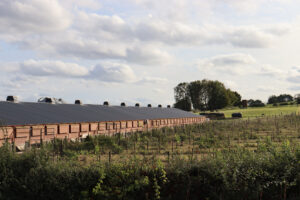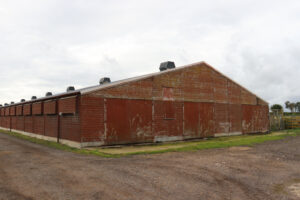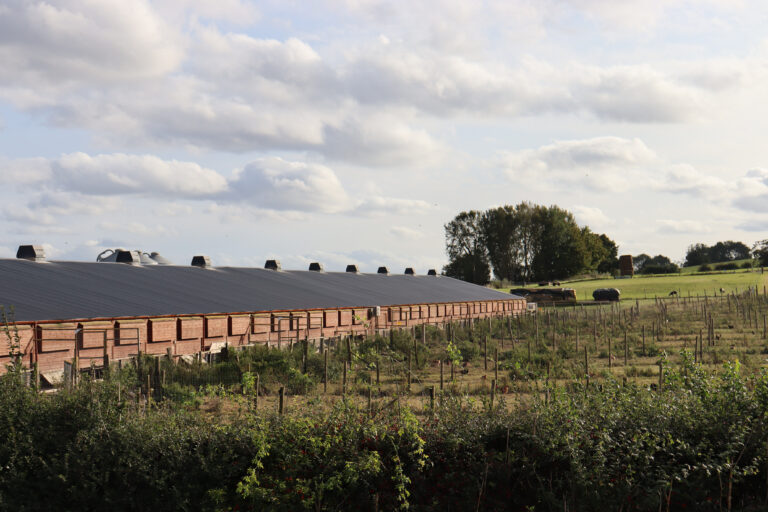Building a new poultry house provides the perfect opportunity to integrate comprehensive biosecurity measures. Livetec Systems biosecurity adviser, Jack Hughes, shares the main considerations to factor into a new, or existing, building’s blueprint.
As Highly Pathogenic Avian Influenza (HPAI) continues to pose an increasing threat to UK poultry producers, the importance of robust biosecurity is being reinforced.
However, it is not just because of HPAI that biosecurity is high on the agenda, it plays a key role in day-to-day disease management, explains Livetec Systems biosecurity adviser, Jack Hughes.
“Every day presents an opportunity for disease challenges to enter poultry houses, but strong biosecurity measures can help prevent a loss of production, mortality and income,” he says.
“Bearing this in mind, we’re encouraging producers building new houses or sites to make biosecurity as robust as possible right from the planning stage.
“Therefore, we work closely with poultry producers to carry out biosecurity assessments and review poultry site plans, offering recommendations to ensure biosecurity is optimised from the outset. Making this investment at the start can pay dividends in optimising bird performance and mitigating disease threats.”
Hughes highlights four key factors to consider when developing a new site: structural biosecurity, site location, vehicle and pedestrian access, and entry points to the units and live bird areas.

Structural biosecurity
Structural biosecurity refers to any permanent elements, such as building design and site access, that help prevent disease introduction.
“This is the first thing to consider when planning farm biosecurity, as it can’t be changed easily and must work day-to-day,” says Hughes.
“Think about how vehicles will enter the site and consider the best location for vehicle cleaning and disinfection points.”
Pedestrian access should also be considered.
“Nobody should just be able to enter the site through an open gate,” explains Mr Hughes.
“Establishing a perimeter control point is essential for biosecurity, where all personnel must pass through a designated building to change footwear, clothing, and put on appropriate PPE before entering the site.”
He says it is crucial to evaluate whether non-essential vehicles need to enter the site at all.
“Restricting access and transferring goods or equipment at the perimeter can significantly reduce the risk of contamination – keeping staff and visitor vehicles off-site further strengthens biosecurity – by minimising potential disease transmission pathways,” he says.
“The goal is to minimise the amount of people entering the site,” adds Hughes.
“The fewer people who enter, the lower the risk of a disease challenge entering.”

Site location
Site location is a particularly important consideration especially in areas deemed at high risk of avian influenza by the Animal and Plant Health Agency (APHA), or sites located near to watercourses, ponds or wild birds where disease pressure is naturally higher.
Hughes notes that the orientation of the house, along with the location of feed bins, manure conveyors, and egg stores requires careful planning.
“This is particularly the case on laying hen sites where manure may be removed during the flock cycle and eggs are collected up to three times a week. These elements should be strategically positioned to minimise vehicle movement around the site and reduce biosecurity risks,” he says.
When selecting a site location, he recommends consulting the Livestock Protect app, which won Innovation of the Year at this year’s National Egg and Poultry Awards (NEPA), to check for disease pressure in the area.
“The app is available in three packages, including a free app-only version that provides access to essential features,” explains Hughes.
“It provides real-time AI outbreak mapping which gives producers visibility of disease threats, and our biosecurity chatbot provides instant access to expert advice if needed,” says Hughes.
“The premium and enterprise packages also offer additional tools such as eBAS – our unique biosecurity assessment system that delivers weighted risk scores and bespoke recommendations for each farm – as well as AccessProtect, which enables visitor logging.”
Intermediate area
In a laying house, the intermediate area is the egg collection area, while in a broiler house, it is the room just before entering the bird area.
Hughes advises that in egg-laying houses, staff are likely to spend more time in the intermediate space.
“To maintain biosecurity, ensure this area is equipped with everything staff need – such as a toilet or space for food and drink – to minimise the need to move to different areas and lower the risk of contamination,” says Hughes.
In both types of houses, if shower-in and shower-out facilities are being installed, Mr Hughes says they should be constructed so that they are impossible to be bypassed.
“People are often in a rush onsite, and it’s natural for them to skip steps if they can,” he explains.
“On broiler sites, several people will be entering the site for thinning, and it can be hard to manage biosecurity at this point.
“To minimise risks, locate toilets and showers carefully to ensure workers don’t need to leave the biosecure area during their visit.”
He adds: “There should also be a physical barrier when entering the intermediate area, where people can sit down to change footwear and swing their legs over, preventing cross-contamination between zones.”
Live bird area
The final stage when entering a poultry house is reaching the live bird area.
To maintain biosecurity in a new, or existing, house, a barrier should be in place between this and the previous area, allowing for a final shoe change, Mr Hughes explains.
“By the time you enter the birds, shoes should have been changed three times,” he says.
“A factor we see often forgotten is control panel location; These are often in the intermediate area, but when adjustments are needed, people often forget to change shoes, compromising biosecurity.”
Hughes says simplicity is key and adds: “Biosecurity measures must be carefully planned from the start, as it’s difficult to make changes later on.
“Building a new poultry house offers the perfect opportunity to ensure effectiveness from day one.”


